Blogs
Short articles that discuss data center networking solutions

Be more agile with EVPN Multihoming (MH)
Thu, 04 Jan 2024 16:51:10 -0000
|Read Time: 0 minutes
Let’s talk about enhancing your basic EVPN fabric. In your typical data center EVPN fabric, an end host uses dual homed connections onto the leaf or Top of Rack (ToR) switches.
The ToRs are usually a pair of switches configured with multi-chassis link aggregation (MC-LAG) to provide end-host link redundancy if one of the ToRs failed.
These links are Layer 2 with spanning-tree deployed on the fabric. Spanning tree typically blocks half of the links to avoid any network loops. As a result, the fabric bandwidth is cut in half. This only happens when the LAG consists of single links, as demonstrated in Figure 2.
However, if there was a way to attain link redundancy, flexibility, and full link bandwidth utilization things could be more interesting in the EVPN landscape.
Dell Enterprise SONiC 4.2 brings EVPN multihoming into the data center. It is a standards-based replacement for multi-chassis link aggregation (Multi-chassis Link Aggregation Group) and legacy stacking technology.
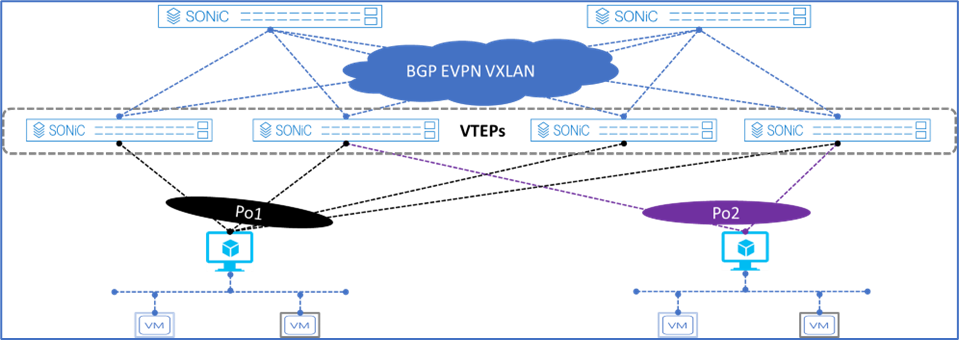
Figure 1. Dell Enterprise SONiC EVPN MH
Figure 1 shows the supported Dell Enterprise SONiC EVPN MH deployment. It shows the maximum number of VTEPs that can be connected to a single end host.
These connections are independent, meaning each link belonging to the link aggregation (LAG) can be connected to multiple independent upstream switches and these upstream switches do not have to be interconnected.
Deployment simplicity is the main benefit of EVPN MH, as all the connections only have to be connected from the end-host or server to the switches.
Achieve end host enhanced connectivity and link efficiency with EVPN MH
In an EVPN fabric, especially a data center fabric, the end hosts or servers are dual homed to a pair of Top of Rack (ToR) switches providing link redundancy. This deployment is common and it uses MC-LAG.
The other deployment option is known as stacking. This option involves several switches stacked together with a primary switch acting as the controller of the stack. All end-hosts or servers are connected to each of the switches part of the stack.
Note: A stack consisting of a single switch is also possible, but rarely deployed.
Both deployments offer link and device redundancy, but they have some limitations that EVPN MH can overcome. The benefits and limitations for each deployment option are described in the following lists.
MC-LAG deployment
- A minimum of two ToR/Leaf switches are required
- A single switch deployment is not supported
- An end host or server can connect only up to two ToRs/Leaf switches at any given time
- All connections from the end-host or server are Layer 2 based
Stacking deployment
- A maximum of eight switches are stacked with one primary or controller switch
- Specific types of stacking cables are required to form the stack
- A single switch deployment is not supported
- All end hosts or servers connect to each switch part of the stack to maintain link redundancy, resulting in a cable management situation
- All connections from the end-host or server are Layer 2 based
EVPN multihoming deployment
- A minimum of one ToR/Leaf switch is required
- An end-host or server can connect to four separate ToR/Leaf switches (VTEPs) at any given time
- All links from the end-host or server to the VTEPs are active
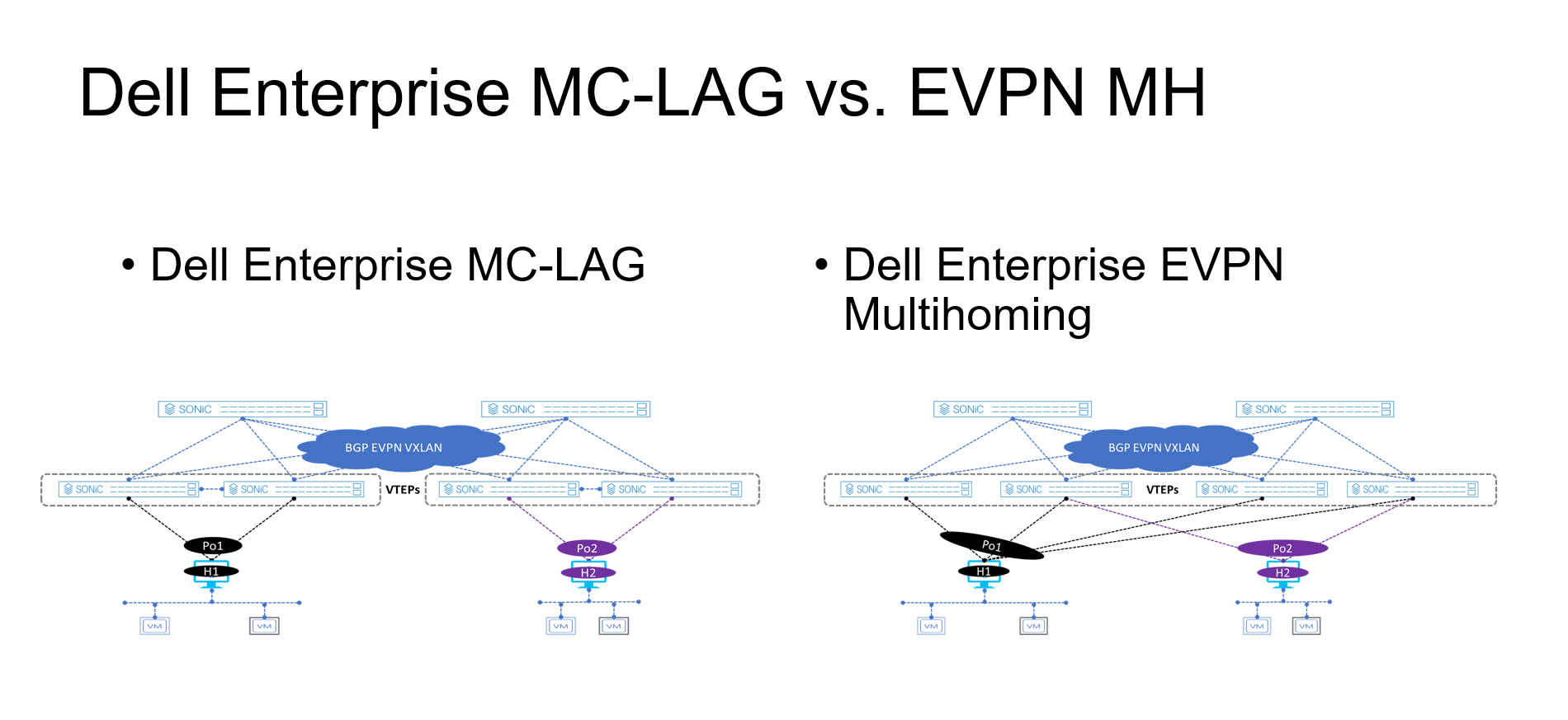
Figure 2. MC-LAG vs. EVPN multihoming deployment
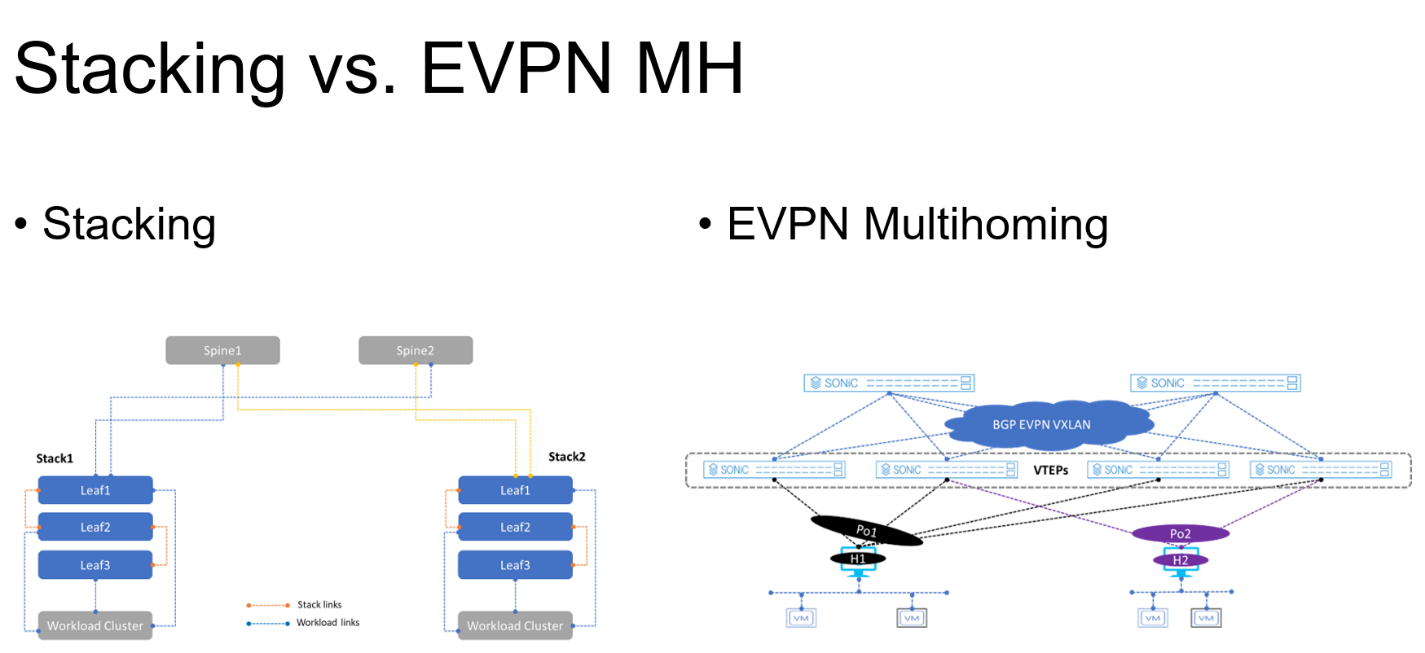
Figure 3. Stacking vs. EVPN multihoming deployment
The advantages offered by EVPN multihoming are clear when compared with the traditional stacking and MC-LAG. Table 1 summarizes these differences.
Table 1. Stacking compared to MC-LAG and EVPN-MH
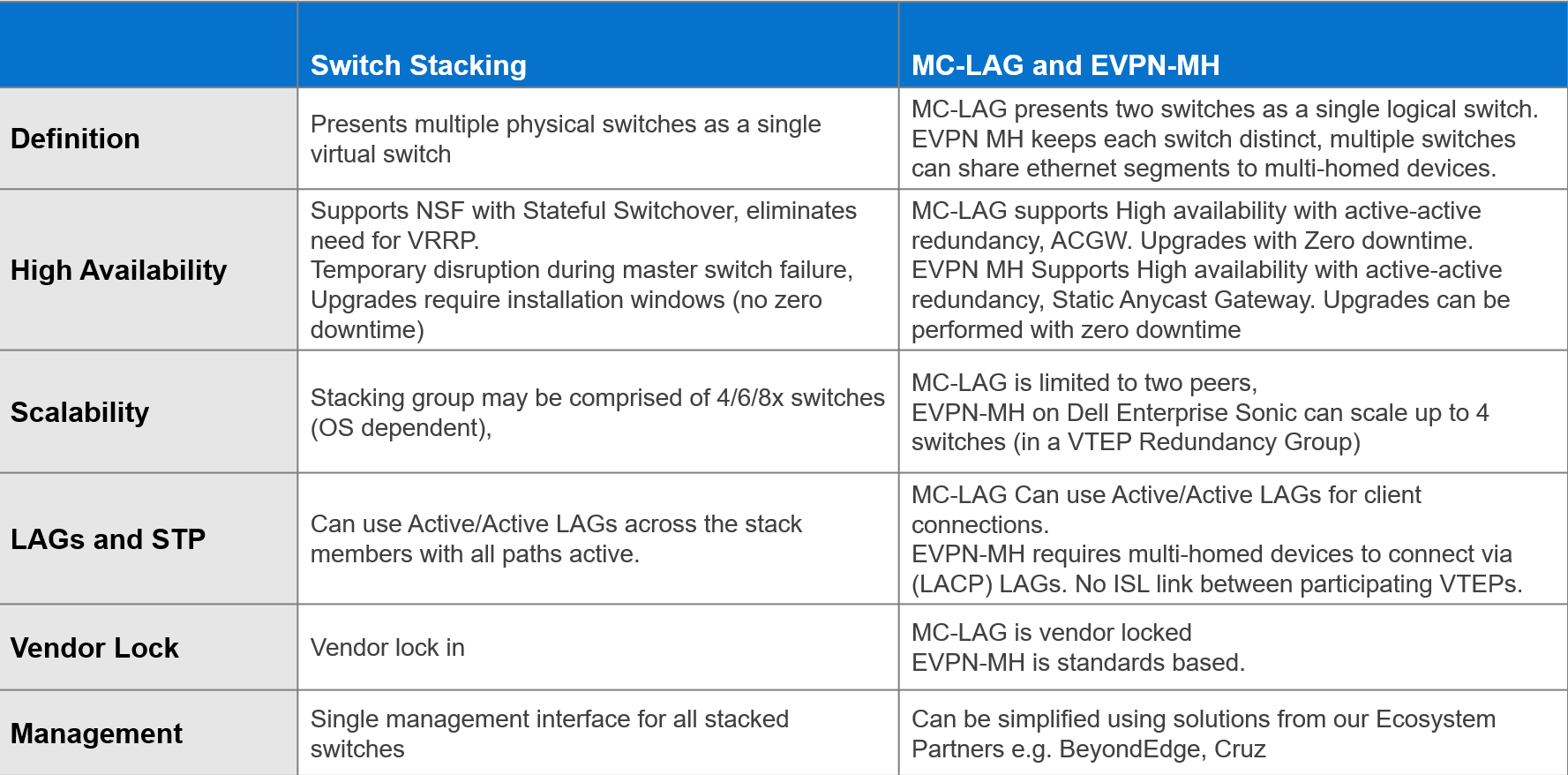
EVPN offers an upgrade to the legacy Layer 2 VPN technology. EVPN should be considered each time a new fabric is deployed, especially when virtualization is one of the workloads.
Dell Enterprise SONiC 4.2 offers even more simplicity into the adoption of EVPN in the data center.
Additional resources
Dell Enterprise SONiC 4.2.0 User Guide (log in required)

Transform Your Data Consumption with Dell Enterprise SONiC and PowerFlex Appliance
Thu, 28 Sep 2023 18:16:45 -0000
|Read Time: 0 minutes
Different types of data generated by our everyday needs defines our digital world. To survive the constant evolution of this world, transformation should be the first order of business. One way to spark transformation is by developing the ability to intelligently leverage the data we produce.
Data centers are the convergence of software and hardware elements that provide predictable outcomes for mission-critical workloads. These workloads need to reside and evolve within a well-defined infrastructure.
This infrastructure is known as hyperconverged or converged infrastructure, where compute, networking, and storage components work together in a single appliance.
Dell Technologies’ product portfolio has several hyperconverged/converged (H/CI) platforms, one of which is VxRail, and PowerFlex, which facilitates this transformation.
This blog introduces PowerFlex, as well as Dell Enterprise SONiC, an open-source networking operating system. These appliances complement each other and serve as a holistic solution for your H/CI needs.
Dell PowerFlex: The basic pillars of digital transformation
The Dell PowerFlex family empowers organizations to leverage the benefits of fully integrated, high-power appliances to achieve predictable outcomes. It brings three key pillars: flexibility, high performance, and linear scalability. These pillars work together to simplify infrastructure management, increasing IT agility overall.
PowerFlex offers the flexibility to meet the diverse and rapidly evolving needs of the modern data center and IT Enterprise. For example, PowerFlex allows for mix and match storage, compute, and hyperconverged nodes for a dynamic deployment. This flexibility allows users to scale their storage and compute resources together or independently.
PowerFlex also supports a wide range of operating environments: bare metal operating systems, hypervisors, and container platforms. It offers a robust toolset for simplifying IT operations for the entire infrastructure with PowerFlex Manager, automating complex life cycle management activities.
The transformation pillars of flexibility, performance, and scalability need a foundation on which to build to deliver the predictable outcomes. The infrastructure or fabric is that foundation—and Dell Enterprise SONiC is the networking operating system that builds this fabric.
Dell Enterprise SONiC: Open-source networking made real
SONiC is an open-source, Linux-network operating system. It started in the cloud-scale data center for a hyperscale deployment model. Its modular or container-based architecture allows it to expand into increasingly applicable edge, cloud, and Enterprise deployments.
Dell Enterprise SONiC is Dell’s own version of the SONiC community version. Dell’s version contains Dell proprietary features that provide the foundational fabric for our edge, cloud, and Enterprise customers delivering H/CI environments such as PowerFlex solutions.
H/CI environments require some basic networking features such as jumbo frames, link aggregation, line-rate performance, Quality of Service (QoS), simple Spanning-Tree port types (portfast/edge), and VLANs.
In addition to these basic Layer 2 features, Dell Enterprise SONiC provides VxLAN EVPN, Data Center Interconnect (DCI), MC-LAG, PoE, PoE+, 802.1x, and additional features for the edge, cloud, and Enterprise environments.
With Dell Enterprise SONiC, our customers can:
- Leverage the entire open networking product portfolio to facilitate transitions between platforms
- Deploy alert framework and streaming
- Have access to a growing third-party application ecosystem
- Count on round-the-clock, single-source, world-class support
 Dell Enterprise SONiC Distribution by Dell Technologies
Dell Enterprise SONiC Distribution by Dell Technologies
The best of both of worlds
By combing PowerFlex and Dell Enterprise SONiC, you get the best of both worlds. When working alongside each other, these solutions deliver scalable databases, provide deep insight with next generation analytics, and consolidate IT systems to improve efficiency. Additionally, these solutions help integrate your cloud native applications, and bring together bleeding edge applications such as artificial intelligence and machine learning to create revenue streams.
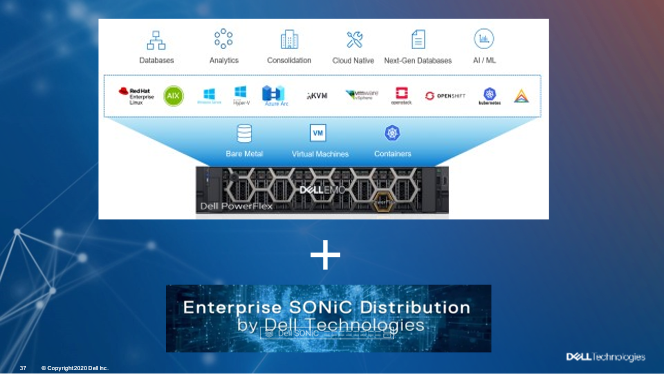 PowerFlex Appliance plus Dell Enterprise SONiC – a good match
PowerFlex Appliance plus Dell Enterprise SONiC – a good match
Dell Enterprise SONiC brings open-source networking to the H/CI ecosystem by providing various competitive benefits. These include open architecture, community-driven development, vendor-neutrality, as well as enhanced scalability, performance, and security features. These benefits help to improve the efficiency, reliability, and security of an H/CI environment.
Together PowerFlex and Dell Enterprise SONiC deliver a unique solution based on innovative infrastructure open source for the next generation cloud, edge, and Enterprise IT providers for mission-critical workloads running on top of a hyperconverged or converged infrastructure.
For more information about these solutions, see the Dell Technologies Enterprise SONiC for PowerFlex Deployment Guide.

Dell Enterprise SONiC Flexible and Robust VLAN QinQ, VXLAN, and VLAN Translation Solutions
Wed, 24 May 2023 17:24:24 -0000
|Read Time: 0 minutes
As a corporate business grows through mergers, acquisitions, and expansions, it must add or extend new business branches in many different locations. The network infrastructure must evolve to accommodate these new locations. Compute and network virtualization have also brought strong demand and requirements to transport local VLAN over WAN (Wide Area Network), Telco (Telecommunication), and many other network infrastructures.
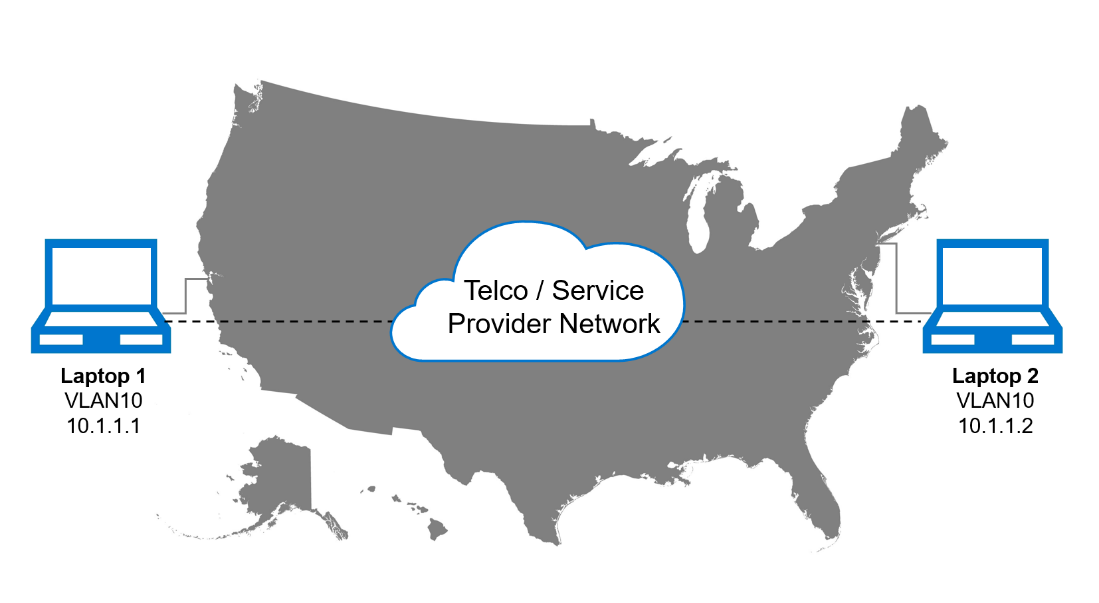
Figure 1. Transport VLAN network through WAN network
In Figure 1, Laptop 1 is connected to the corporate network in San Francisco. Soon after, Laptop 2 was added to the same corporate network in New York. The users of these two laptops are in the same corporate business unit (BU), such as engineering, finance, or HR. Corporate IT wants to apply the same set of policies for network access, security, and service to these laptops. These policies are implemented through VLAN IDs, subnets, and other network provision parameters. Therefore, IT must transport the VLAN ID over WAN and its network infrastructures. Often, on corporate networks, endpoints must be on the same VLAN. These endpoints can be laptops, VMs, applications, and Virtual Network Function (VNF) entities, to name a few.
To help customers meet these network transport requirements, Dell Enterprise SONiC has built the new IEEE 802.1ad VLAN QinQ feature. This feature adds another VLAN tag in the original dot1q frame, creating a double-tagged VLAN frame.
The figures below demonstrate how the outer tag is used to identify the Telco provider’s traffic, while the inner tag is still the local dot1q VLAN ID. This process allows endpoints to use the same VLAN ID while traveling through Telco network infrastructures.
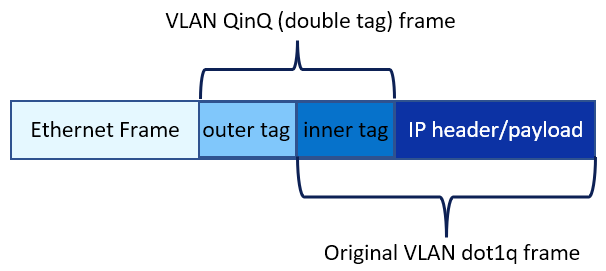
Figure 2. VLAN QinQ frame
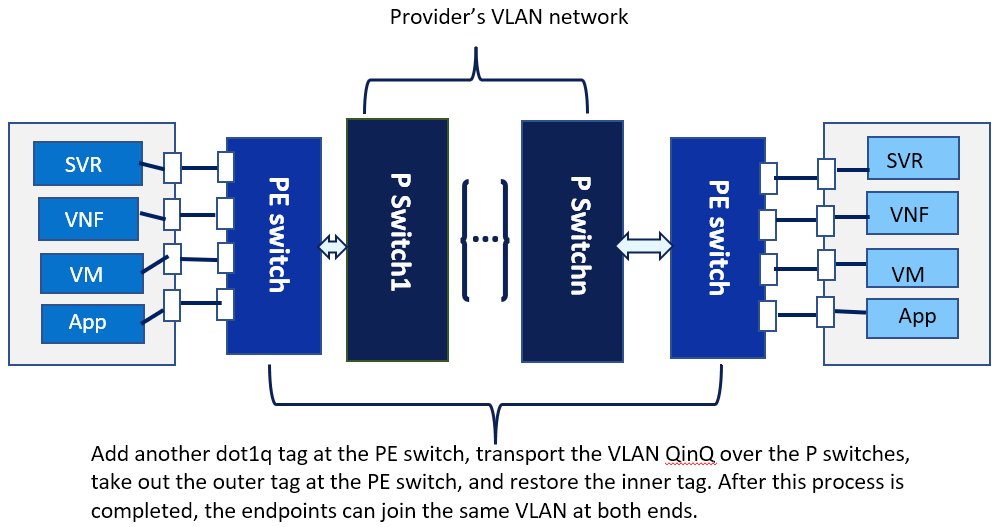
Figure 3. Transport local dot1q VLAN over VLAN QinQ enables switches
Dell Enterprise SONiC VXLAN (Virtual Extensible LAN) solution is designed to transport VLANs in Layer 4, the User Datagram Protocol (UDP) transport layer, which is defined in the Open Systems Interconnection (OSI) model. Packets that VXLAN encapsulates are not aware of the underlay networking protocols.
The figures below demonstrate how the VXLAN IP/UDP header is created in a VXLAN tunnel endpoint (VTEP) ingress tunnel server and decapsulated in the egress VTEP server.

Figure 4. VXLAN header to encapsulate dot1q VLAN frame
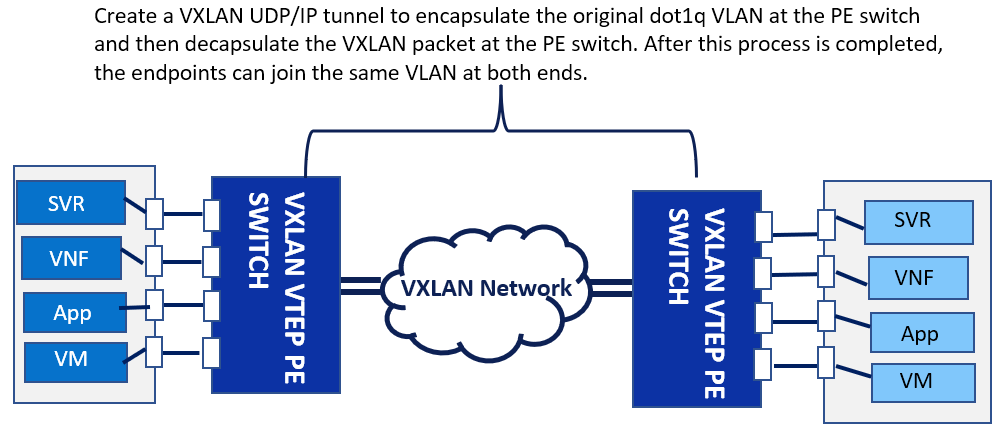
Figure 5. Transport dot1q VLAN frame over VXLAN enabled network infrastructure
Network infrastructures in Telco, Communication Service Provider (CSP), data center, and cloud providers often consist of different types of VLAN transportation technologies like QinQ, VXLAN, and dot1q. To transport VLAN frames over a mix of VLAN protocol networks, Dell Enterprise SONiC introduces the VLAN translation feature with the following options:
- Dynamically modify the tag in a single tag VLAN frame
- Dynamically modify one tag and remove the other in a double tag VLAN frame

Figure 6. VLAN translation to modify VLAN tags
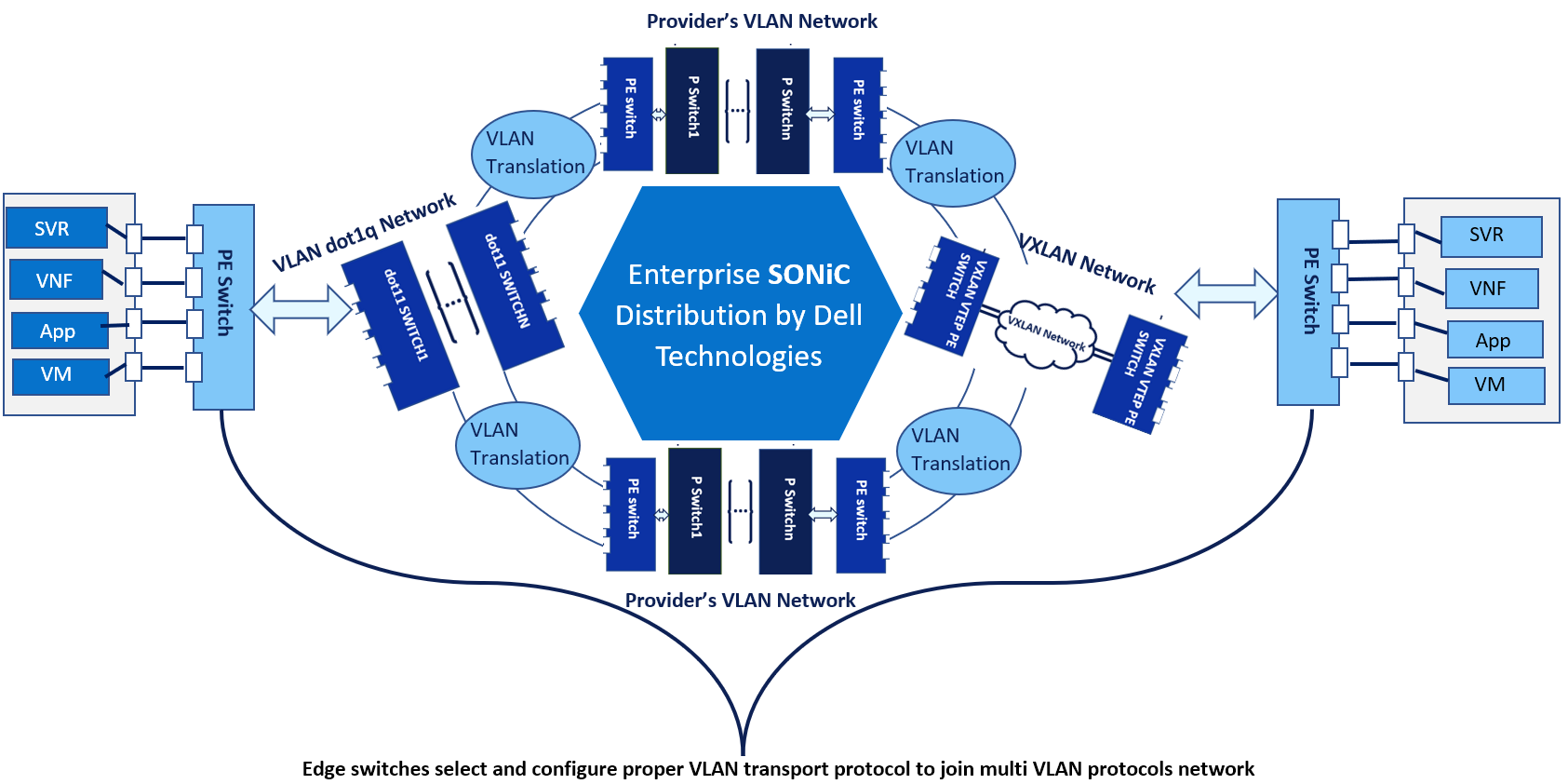
Figure 7. Illustration of Dell SONiC VLAN translation, QinQ, and VXLAN sample scenarios
Network service providers constantly face technical challenges and stringent requirements. For example, one common challenge is determining how to scale bandwidth up and out to address fast and spontaneous traffic growth. Other challenge include protecting and securing the networks through user and tenant isolations, or improving network efficiency.
Open source-based SONiC network software provides rapid feature development and a broad selection of network orchestration tools through a vibrant ecosystem and community. On top of that, Dell Enterprise SONiC has added special features and verifications, such as world class technical support for Dell networking hardware. This support can improve network security and flexibility, as well as increase network provisioning and monitoring capabilities.
Contact a Dell SONiC sales representative for additional information about Dell Enterprise SONiC solutions and technologies.
Contact Dell SONiC Sales representatives
Resources
To learn more about Dell Enterprise SONiC features, see the Enterprise SONiC Spec Sheet.
To learn more about Enterprise SONiC Distribution by Dell Technologies, see Enterprise SONiC Networking Solutions, Enterprise SONiC Distribution By Dell Technologies, and Dell SONiC Solution Overview.
For more information about specific steps and commands, see the Dell SONiC User’s Guide available on the Dell Digital Library.

Unlock the Power of RoCEv2 with Dell Enterprise SONiC: High-Speed Storage Transfer without Cost and Complexity
Mon, 22 May 2023 21:20:56 -0000
|Read Time: 0 minutes
In today's data-driven world, the demand for high-speed, low-latency data transfers is increasing exponentially. Traditional Ethernet networks are not designed to meet these demands, as they were primarily built for data integrity and networking reliability. As a result, organizations are turning to more advanced technologies like Remote Direct Memory Access (RDMA) to achieve faster data transfers.
Although RDMA is typically used in InfiniBand (IB) networks, which are complex and expensive to deploy, RDMA over Converged Ethernet (RoCE) has emerged as a more accessible solution.
In this blog, we will explore the benefits of RoCE and how Dell Enterprise SONiC can help you take advantage of this powerful technology. Keep reading if you want to:
- Understand what RoCEv2 is and how it can benefit your organization
- Find ways to optimize your storage networking and achieve faster data transfer speeds
- Learn how the power combination of RoCEv2 and Dell Enterprise SONiC will help you achieve unparalleled data transfer speeds and reliability
What is RoCE?
RDMA Consortium—a group of industry leaders that includes Dell Technologies—developed RoCE to address the need for faster, more efficient data transfers in modern data centers. The first version of RoCEv1 was released in 2010 and supported Layer2 ethernet encapsulation for RDMA.
RoCEv2 was introduced in 2014 and builds on the original RoCEv1 protocol. It added key features such as support for routing and congestion control, making RoCEv2 a more robust and scalable solution for modern data centers.
How does RoCEv2 work?
RoCEv2 enables RDMA over Ethernet networks by using the Ethernet header and payload to transport RDMA messages.
Below is an example of two RDMA-aware servers connected using an Ethernet fabric enabled with RoCEv2:
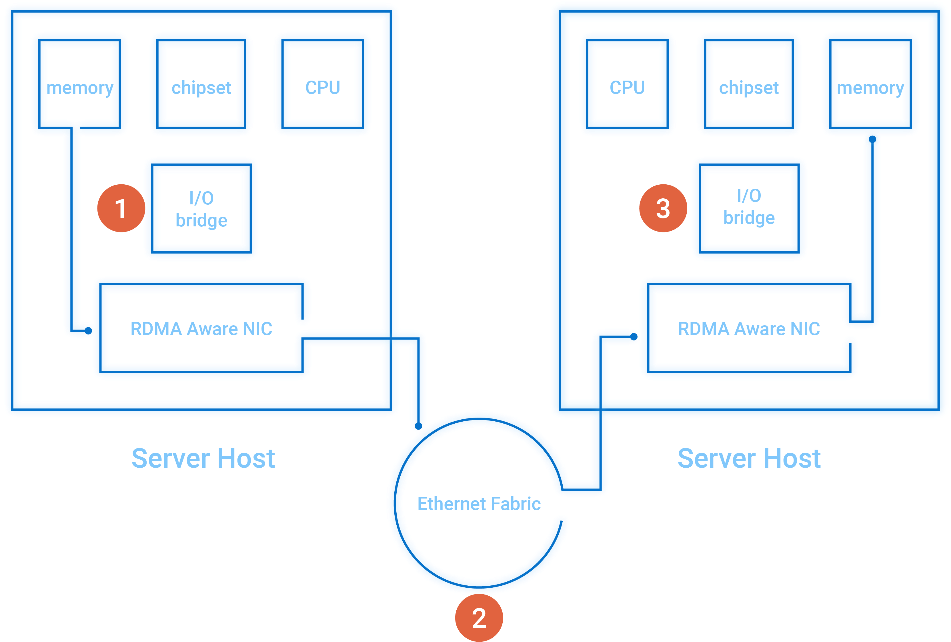
- The sending NIC prepares an RDMA message by copying data directly from the local memory into the NIC's send buffer. The message can be for example, to initiate an RDMA write operation, specifying the destination server’s memory address and the amount of data to be transferred.
- The RDMA message is translated into an Ethernet frame by encapsulation and sent over the Ethernet fabric to the receiving NIC.
- The receiving NIC receives the packet, decapsulates it from the Ethernet frame, and copies the data from the RDMA message directly to the remote memory.
Because RoCEv2 bypasses the CPU and operates directly on the memory, it can achieve lower latency and overhead than traditional network communication. This makes RoCEv2 ideal for high-performance computing applications that require fast data transfers such as machine learning, big data analytics, and scientific computing.
How does RoCE help with storage networking?
RoCEv2 is a technology that provides high-speed, low-latency data transfers by leveraging RDMA over Ethernet networks. As such, it is well suited for storage networking applications, where fast and reliable data transfers are critical.
Additionally, RoCEv2 is designed to be compatible with existing ethernet infrastructure. This makes it a powerful tool for organizations looking to improve storage networking performance without significant infrastructure upgrades or changes to their existing storage environment.
What is Dell Enterprise SONiC?
Dell Enterprise SONiC is based on an open-source network operating system, designed to provide a flexible and scalable platform for building and managing modern data center networks. SONiC can build efficient and customizable network infrastructures and supports various networking protocols such as Layer 2 and Layer 3 forwarding, BGP, OSPF, VXLAN, and EVPN. It can also extend functionality with custom modules through third-party container management.
A typical RoCEv2 deployment with Enterprise SONiC
In a typical Data Center topology based on Leaf/Spine architecture, the S-series S52xx-ON family of switches plays the role of Leaf while Z-series Z93xx-ON plays as Spine.
Leaf switches are connected to servers and storage devices, while Spine switches are used to interconnect the Leaf switches.
Servers and storage have NICs that are RoCEv2 enabled:
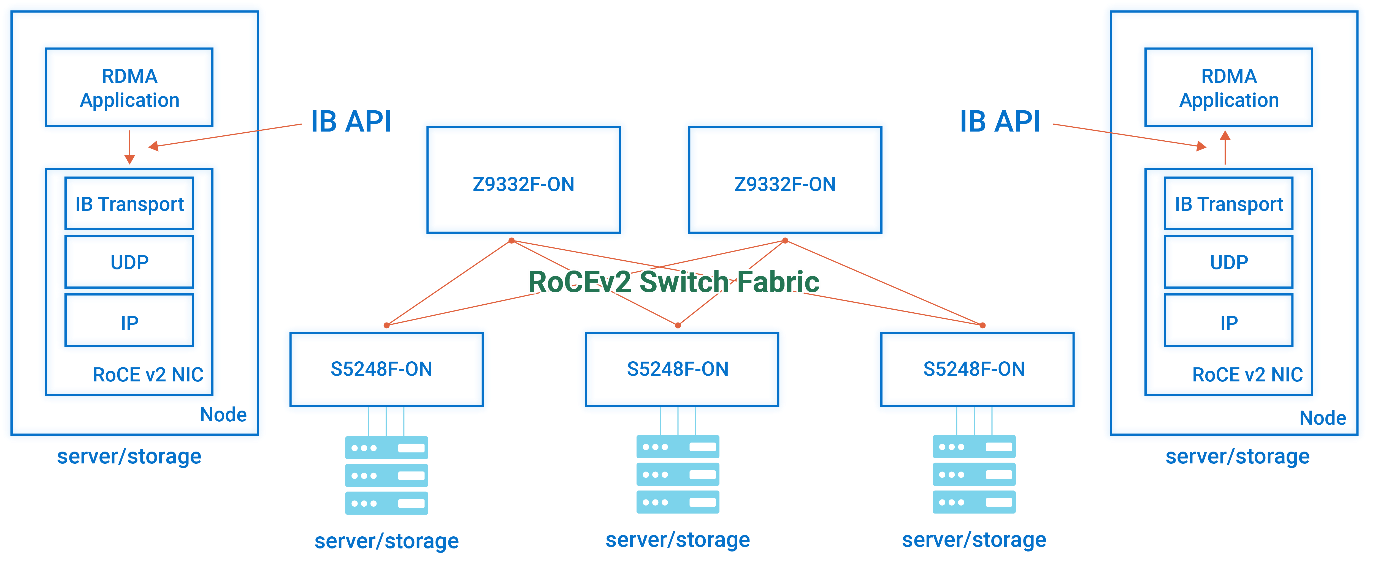
The Layer 2 connectivity of server and storage devices terminates at Leaf. L3 routing is enabled between leaf/spine and uses dynamic routing protocol like BGP to learn all the end points in the network.
The following protocols enable Switch fabric to provide the quality of service (QoS) needed for zero packet loss and to schedule higher priority switching for storage traffic:
- Priority Flow Control (PFC) – provides congestion management by avoiding buffer overflow and achieves zero-packet loss by generating priority-based pause towards the downstream switch
- Enhanced Transmission Control (ETS) – allocates specific bandwidth to each class of service to prevent a single class of traffic hogging the bandwidth
- Explicit Congestion Notification (ECN) – marks packets when the buffer overflow is detected; end hosts check the marked packet and slow down transmission
- Data center bridging protocol – operates with link layer discovery protocol to negotiate QoS capabilities between end points or switches
In terms of operations, Packets are classified and prioritized based on whether it is storage traffic or not at the ingress Leaf. They are tested for congestion at each subsequent switch in the path of the packet towards the destination server.
How does Enterprise SONiC take advantage of RoCEv2?
Enterprise SONiC supports a wide range of capabilities, including modular architecture based on docker container technology, easy automation, third-party container management (TPCM), and other comprehensive features that allow deployment at Enterprise, Edge, and Provider networks. Networks that combine Enterprise SONiC and RoCEv2 can help organizations build high performing, reliable, and scalable network infrastructures.
The most important benefit of RoCEv2 with SONiC is that it reduces the complexity of configuring RoCEv2 to a single CLI command (command: roce enable]. This addresses one of the major complaints against RoCEv2 as being difficult to configure as there are several features to handle like buffering, traffic classification, mapping, queuing, scheduling, priority flow control, congestion management.
Additionally, it is also necessary to ensure that these features and parameters align with switch hardware resources. Not only does the single CLI command address this concern, but it also lends a big differentiator to the solution.
TPCM allows flexibility for deploying any third party developed management tools to monitor RoCEv2 or any other applications.
Why Dell Technologies?
With its expertise in networking and storage, Dell Technologies is uniquely positioned to help customers unlock the full potential of RoCEv2. This end-to-end solution ensures a seamless and reliable deployment, from the server to the storage array, leveraging advanced features like ECN and PFC to minimize congestion and maximize performance.
As data centers continue to evolve, the demand for faster and more efficient data transfers will only increase. RoCEv2 is a catalyst of this transformation, and Dell Technologies is at the forefront. With its powerful combination of technology, expertise, and support, Dell Technologies is well positioned to help customers meet their business goals—today and in the future.
How do I learn more?
- See Enterprise SONiC Spec Sheet for more information about Dell Technologies Enterprise SONiC features.
- See Enterprise SONiC Networking Solutions to learn more about Enterprise SONiC Distribution by Dell Technologies.

Dell Enterprise SONiC Distribution and Hyperconverged, converged infrastructure (H/CI)
Tue, 12 Sep 2023 16:43:10 -0000
|Read Time: 0 minutes
Hyperconverged or converged infrastructures (H/CI) combine key integrated components such as storage, compute, and networking into a single appliance to deliver scalable and high-performance resources.
Compared to a non-converged infrastructure—which requires separate, independent teams to converge in order to deliver business applications—H/Cl integration streamlines data center operations.
However, you need a fabric to connect these highly efficient appliances—and fabrics have distinct hardware and software requirements. Without the fabric, these appliances are underutilized, operate separately, and are unable to leverage their powerful resources. The fabric and related hardware and software features (Layer 2 and Layer 3) that interconnect these appliances are crucial.
Enterprise SONiC Distribution by Dell Technologies: a great fit for H/CI
Enterprise SONiC Distribution by Dell Technologies provides the necessary Layer 2 and Layer 3 features and protocols that enable a robust Ethernet fabric. Dell Enterprise SONiC is a modular, scalable, and purpose-built architecture leveraging open networking standards.
You can use Dell Enterprise SONiC to build a variety of converged infrastructure architectures, ranging from a single VxRail appliance to a single cluster or a stretched cluster in a single site.
Through Dell’s Enterprise SONiC EVPN VXLAN implementation, you can build networking overlays that make resources look like they are part of a large, common resource pool. One primary use case representing this common pool is virtualization in data centers.
Figure 1 shows a typical Layer 2 or Layer 3 Dell Enterprise SONiC and VxRail appliances (both single and cluster).
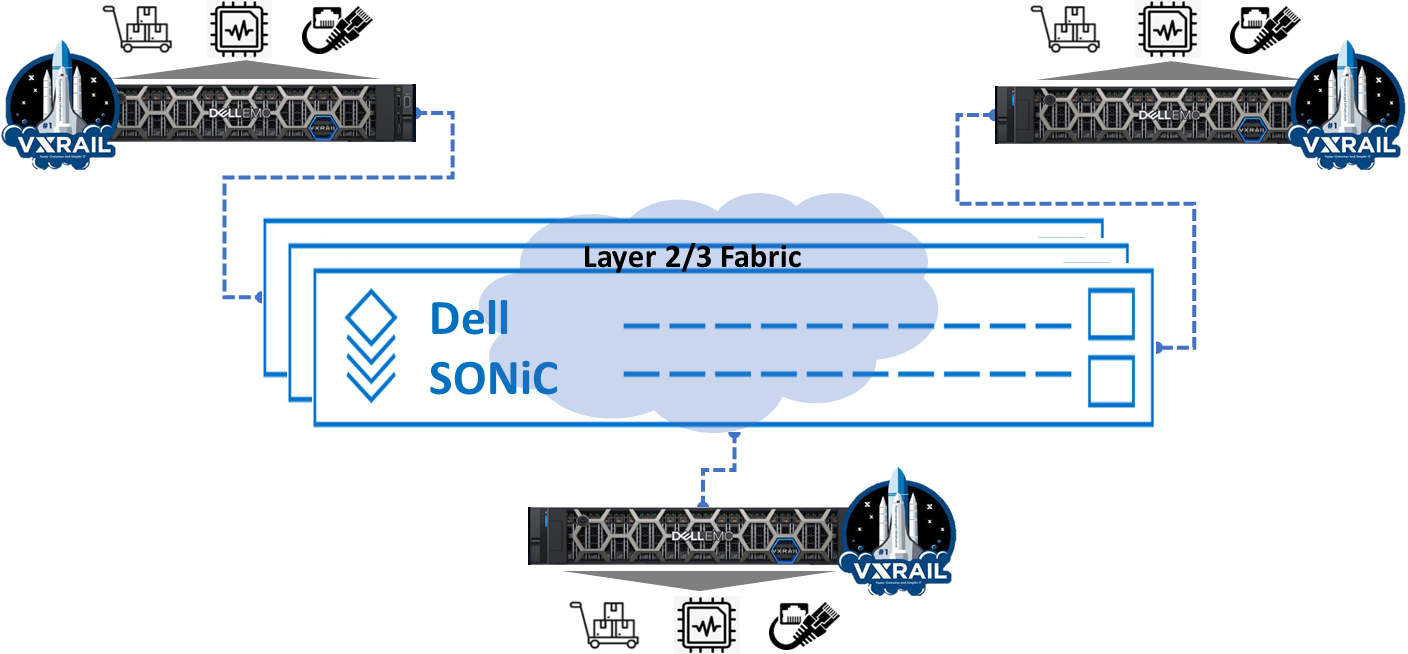 Figure 1 Dell Enterprise SONiC Distribution and VxRail workloads
Figure 1 Dell Enterprise SONiC Distribution and VxRail workloads
A solid foundation
The foundation of a house is similar to an Ethernet fabric, while the roof, framing, and electrical systems represent the integrated components of a Converged Infrastructure appliance. A well-designed Ethernet fabric is just as important as the foundation of a well-built house.
Dell Enterprise SONiC builds and expands on this foundation by providing a robust set of networking Layer 2 and Layer 3 features.
For more information about Dell Enterprise SONiC Distribution and for a detailed VxRail deployment guide with Dell Enterprise SONiC, see:

Data Center Interconnect (DCI) by Dell Enterprise SONiC
Tue, 28 Feb 2023 19:18:19 -0000
|Read Time: 0 minutes
Let’s talk about how Dell Enterprise SONiC is bringing Data Center Interconnect (DCI) into the mix with open source.
A data center is the beating heart of any IT enterprise environment. It used to be a sunk investment, providing little to no return. As the data center evolved into a positive asset that an enterprise could leverage, the ability to interconnect with other data centers became a critical capability. Today, the ubiquitous adoption of virtualization and application services availability is driving demand for integration in current data centers.
The interconnection of data centers is not new; enterprises use many different technologies to interconnect data centers. For example, VPLS or virtual private LAN service is an Ethernet based point to multipoint Layer 2 virtual private network that connects geographically dispersed data centers as if they are connected over a common Layer 2 connection.
Unfortunately, when these technologies were created, they were based on having a Multi-Protocol Label Switching (MPLS) backbone, so deploying them is often complex.
Ethernet Virtual Private Network (EVPN) DCI is all about deploying an overlay based on the familiarity of 802.1q VLANs, that is, stretching Layer 2 over a Layer 3 backbone.
In its first release, Enterprise SONiC Distribution by Dell Technologies supported single-site EVPN fabrics for single-site data centers. As Dell Enterprise SONiC becomes more popular, the fabrics built using Enterprise SONiC need to connect with each other by leveraging simple Layer 2 and Layer 3 technologies.
To achieve this, Dell introduced key EVPN VXLAN components that allow data center interconnectivity.
Let's get together and collaborate
With the proliferation and exponential data growth, the single site data center can no longer absorb or meet the data demands. Connecting multiple data centers to leverage their respective resources is key to the adoption of new applications, services, and overall new business income streams.
Figure 1 shows two typical single site data centers isolated from each other. In this case, the resources (such as storage and compute) reside within a single data center. This type of deployment presents unique challenges, including lack of integration, and potentially site redundancy.
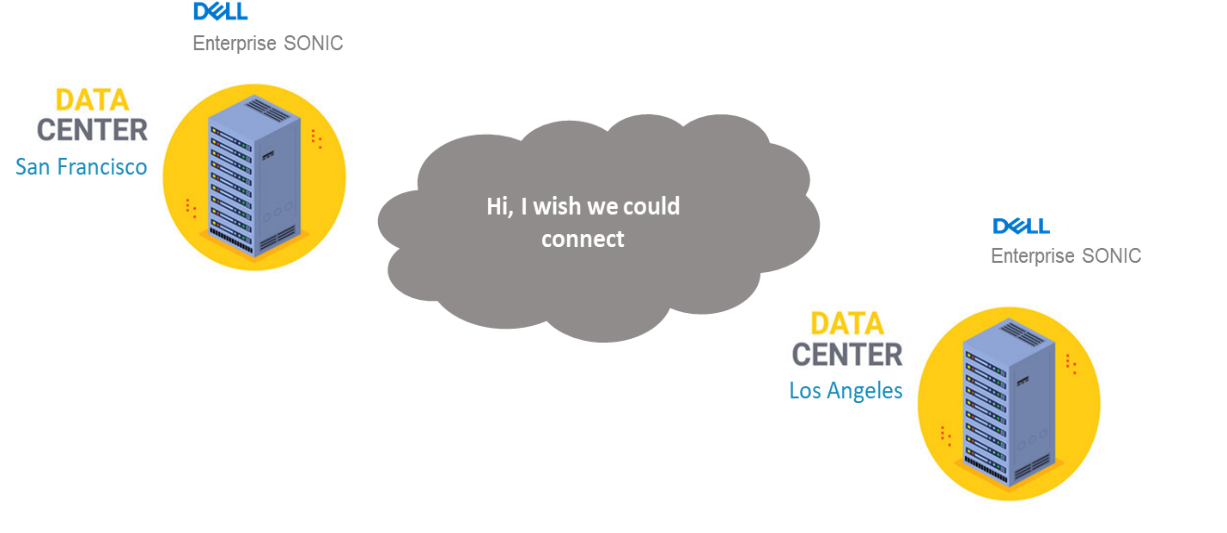 Figure 1 – Typical single site data centers collocated but isolated
Figure 1 – Typical single site data centers collocated but isolated
Figure 2 shows several data centers interconnected over EVPN DCI. Dell Enterprise SONiC version 4.0 introduces the much-needed EVPN VXLAN software feature-set enhancement that allows for different geographically located data centers to interconnect.
This new feature allows multiple use cases such as:
- Workload cluster bring-up
- vSAN stretch cluster
- Efficient resource sharing
- Standards based fabric connectivity
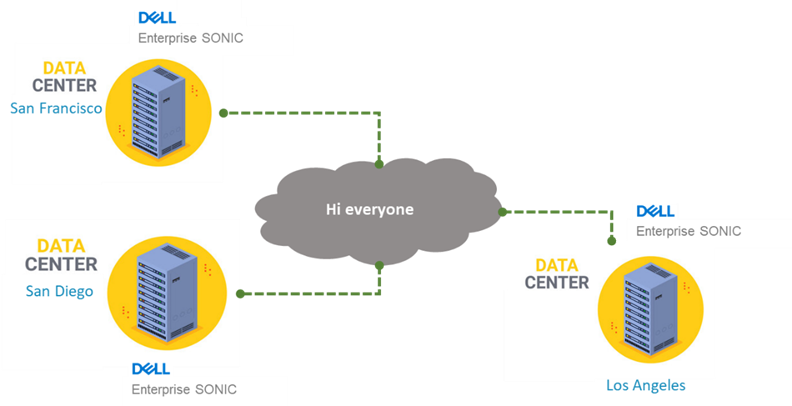 Figure 2 – Full mesh multisite data center connections
Figure 2 – Full mesh multisite data center connections
References
To learn more about Dell Enterprise SONiC Distribution and related solutions please see:
Enterprise SONiC Distribution by Dell Technologies
Enterprise SONiC Distribution Data Center Interconnect Guide
Enterprise SONiC Distribution User Guide
Note: Consult with your Dell sales engineer or representative if access to the Dell Enterprise SONiC User Guide is not available.
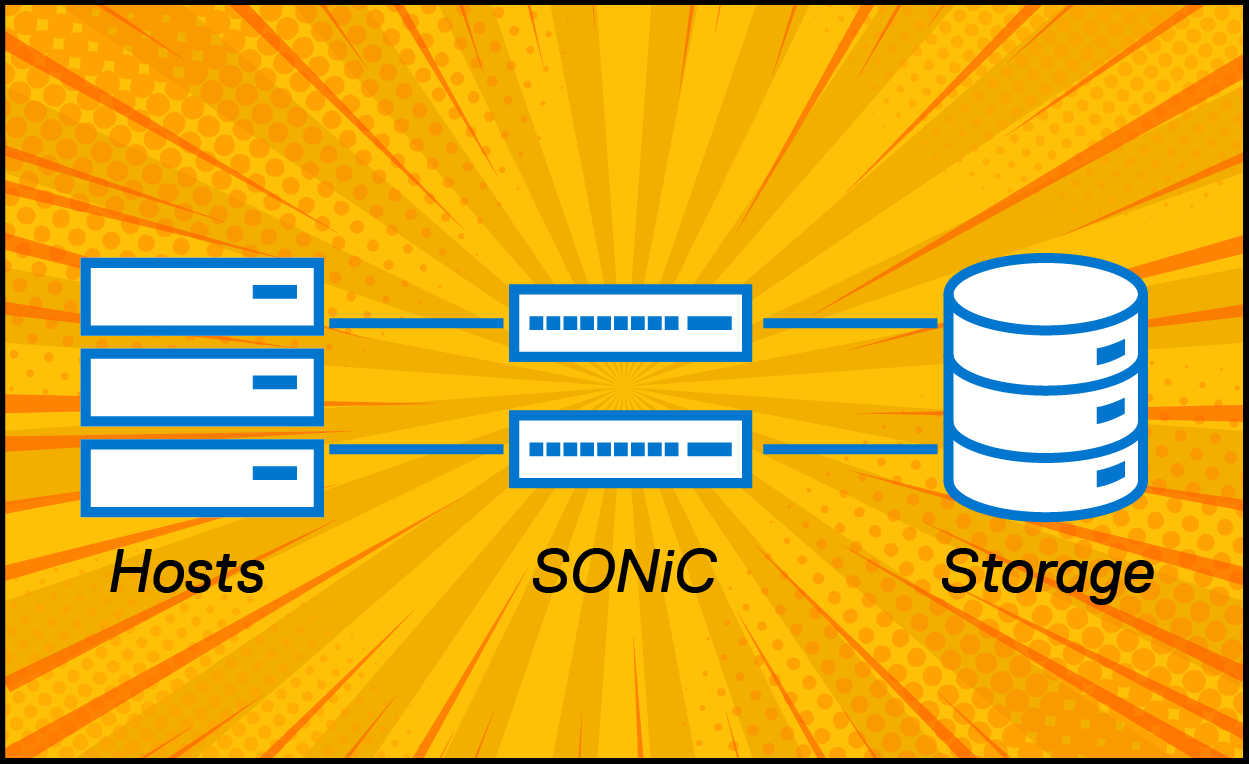
Unleash the Power of NVMe over TCP with Enterprise SONiC by Dell Technologies
Mon, 27 Feb 2023 19:40:41 -0000
|Read Time: 0 minutes
If you’re looking into NVMe/TCP as your new Storage Area Network (SAN) solution, then you already know that you can save on CAPEX and OPEX by using Ethernet instead of Fibre Channel. When selecting an Ethernet switch operating system, check out Enterprise SONiC Distribution by Dell Technologies, which offers a full feature set that covers all of your NVMe/TCP needs and more.
SONiC (Software for Open Networking in the Cloud) is an open-source network operating system based on Debian Linux. Enterprise SONiC Distribution by Dell Technologies builds on the open-source version by adding new features that have been hardened and validated for use in our customers’ environments, all of which is backed by Dell’s world-class support. Combine this with PowerStore or PowerMax storage, PowerSwitch networking, and PowerEdge hosts, and you’ve got a one-stop-shop for your NVMe/TCP solution. To make deploying and managing the solution easier, Dell provides the industry’s first NVMe/TCP Centralized Discovery Controller – SmartFabric Storage Software (SFSS). For more about SFSS, see The NVMe/TCP Dating App!
To learn more about NVMe/TCP, see the NVMe, NVMe/TCP, and Dell SmartFabric Storage Software Overview - IP SAN Solution Primer.
From the networking perspective, NVMe/TCP’s requirements are relatively simple, especially when compared with iSCSI, RoCE, FCoE, and even FC. The network only needs to do what it does best: forward packets from source to destination. The host and storage operating systems, such as ESXi, Linux, PowerStoreOS, and PowerMax, take care of the rest!
 Figure 1: The endpoints do the NVMe/TCP processing, and the network just forwards IP traffic.
Figure 1: The endpoints do the NVMe/TCP processing, and the network just forwards IP traffic.
Enterprise SONiC Distribution by Dell Technologies is a highly scalable and customizable network operating system that can be used to build a storage network of any size, ranging from a simple two-switch setup to a large-scale spine/leaf fabric with thousands of endpoints. SONiC offers several features and functionalities that make it well suited for storage networking, including support for a variety of switching hardware, a modular design that enables administrators to add or remove features as needed, and a strong focus on network automation and programmability.
The SONiC CLI is very similar to that of other commonly used operating systems, meaning it is easy for administrators to learn and adopt. Here’s how simple the switch interface configuration is:
SAN Switch A | SAN Switch B |
interface vlan1921 description SAN_A mtu 9216 ! interface Eth1/1 description NVMeTCP_Endpoint_Port_1 mtu 9216 speed 25000 switchport trunk allowed vlan 1921 no shutdown | interface vlan1922 description SAN_B mtu 9216 ! interface Eth1/1 description NVMeTCP_Endpoint_Port_2 mtu 9216 speed 25000 switchport trunk allowed vlan 1922 no shutdown |
As NVMe/TCP implementations gain traction in data centers, monitoring the performance of the network will be important for network administrators to ensure they get the most from their investment. The good news is that monitoring solutions - like the one offered by Augtera, a Dell partner - make it easy to fold the NVMe/TCP fabric into standard network management solutions. Read more about how Augtera provides proactive detection and isolation of NVMe/TCP congestion using Machine Learning here.
We made quick work of configuring SONiC on Dell PowerSwitch S5248F-ON in our Proof-of-Concept lab. For resiliency and security, we used two air-gapped IP SAN Switches, one for SAN A and one for SAN B, each with a Layer 2 network dedicated to NVMe/TCP traffic. Using dedicated switches and ports for NVMe/TCP removes the risk of contention with LAN traffic. The dual SAN topology creates an active/active resilient solution. Furthermore, this topology provides additional security by constraining NVMe/TCP traffic within Layer 2 networks, resulting in Layer 3 isolation from the rest of the network.
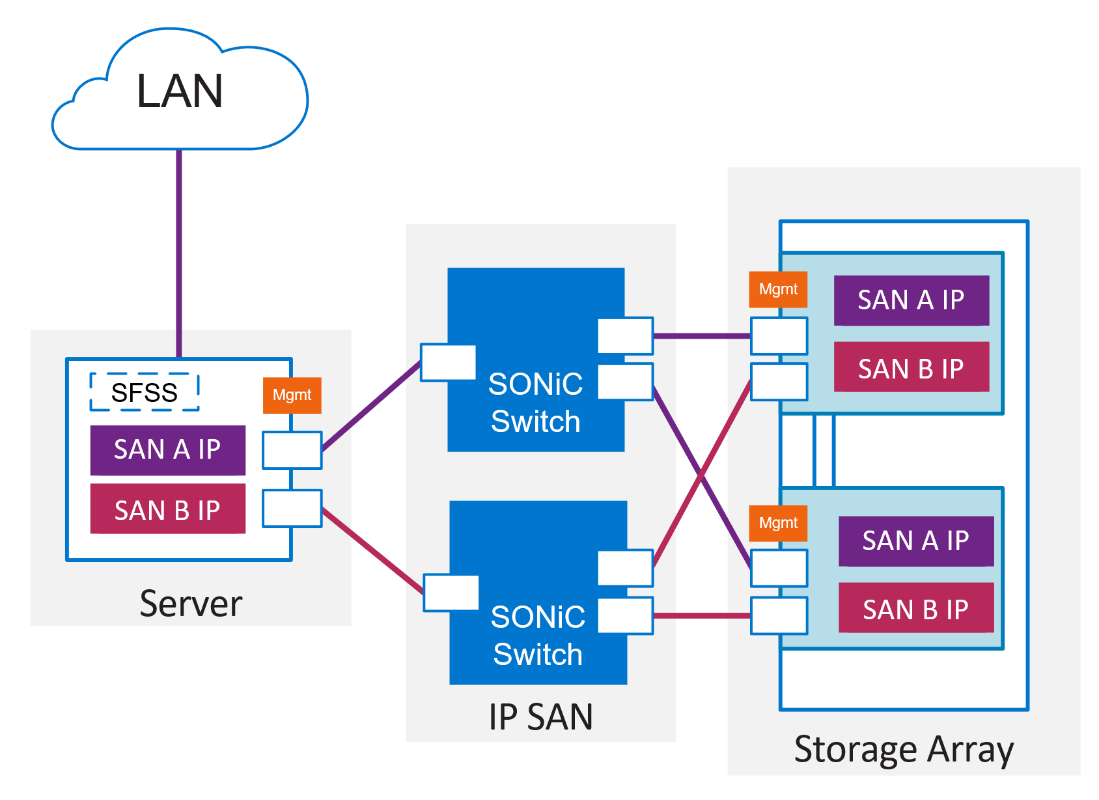 Figure 2: Proof of Concept Topology
Figure 2: Proof of Concept Topology
Enterprise SONiC Distribution by Dell Technologies is used by some of the largest cloud service providers. It is a practical choice for customers who are looking for improved performance, flexibility, reduced cost, and ease of deployment. The combination of Enterprise SONiC with NVMe/TCP makes an attractive option for organizations that need to build large and complex storage networks to meet the demands of their data-intensive workloads.
Contact your sales representative to learn more about how NVMe/TCP with SONiC can benefit your organization. Our experts can provide you with the information you need to make an informed decision and guide you through the implementation process.
Resources
To explore more of SONiC’s features, check out the Enterprise SONiC Spec Sheet.
To learn more about Enterprise SONiC Distribution by Dell Technologies, see Enterprise SONiC Networking Solutions.
Special thanks to Claire O'Keeffe, Zain Raza, and Aarti Utreja!

Enterprise SONiC Distribution by Dell Technologies
Wed, 03 Aug 2022 21:41:04 -0000
|Read Time: 0 minutes
A New Operating System for the Cloud
Cloud computing addresses distributed computing needs that arise from ever-increasing growth and mobility in the telecommunications industry. Cloud computing is performed in a data center that uses spine-leaf architecture. This architecture typically consists of two or three switching layers that use dual-homed connections to provide link redundancy.
The spine-leaf architecture, depicted in the following figure, is based on the following qualities:
- Simplicity
- Scalability
- Uniformity
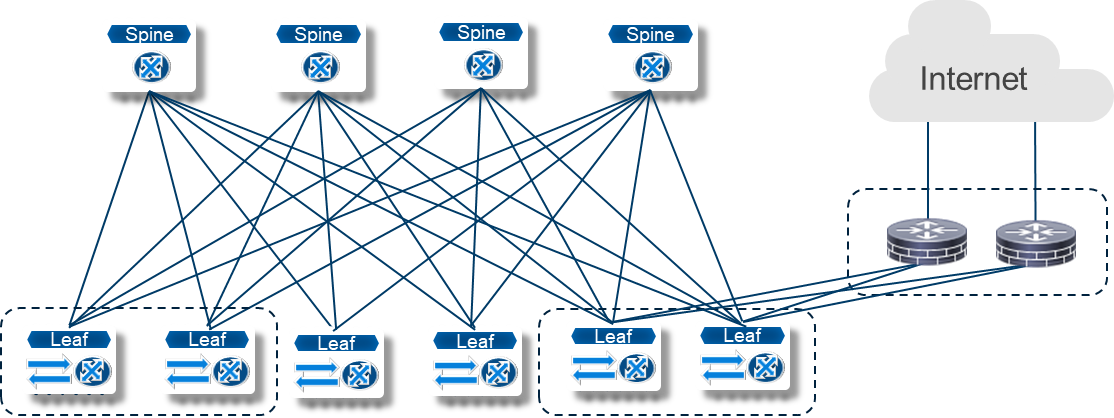 Figure 1—Spine-leaf architecture in a data center
Figure 1—Spine-leaf architecture in a data centerDell Technologies is a proponent of innovation in open networking, as evidenced by Dell Technologies enabling its data center switches to use third-party operating systems. Dell Technologies continues this innovation by adopting SONiC, a free and open-source network operating system designed for scalable infrastructure.
The Enterprise SONiC Distribution by Dell Technologies is based on the open-source SONiC architecture and includes an added set of features and world-class support. Enterprise SONiC Distribution enables network engineers to build a future-proof, scale-out, multitenant, and resilient network usable by single retail stores, large enterprises, or service providers. The following use cases describe how one network can be deployed for diverse uses.
Enterprise SONiC Distribution use cases
Enterprise SONiC Distribution supports several use cases, but three stand out. Each subsequent use case builds on key aspects of the previous use case. The use cases start with a Layer 3 underlay, continue to scalable networks, and end with routing to the host.
Use case 1—Simple network (Layer 3) underlay
To start, use Enterprise SONiC Distribution to build a Layer 3 underlay that leverages Border Gateway Protocol’s (BGP) scalability and active multilink connections between leaf, spine, and super-spine layers, as shown in the following figure.
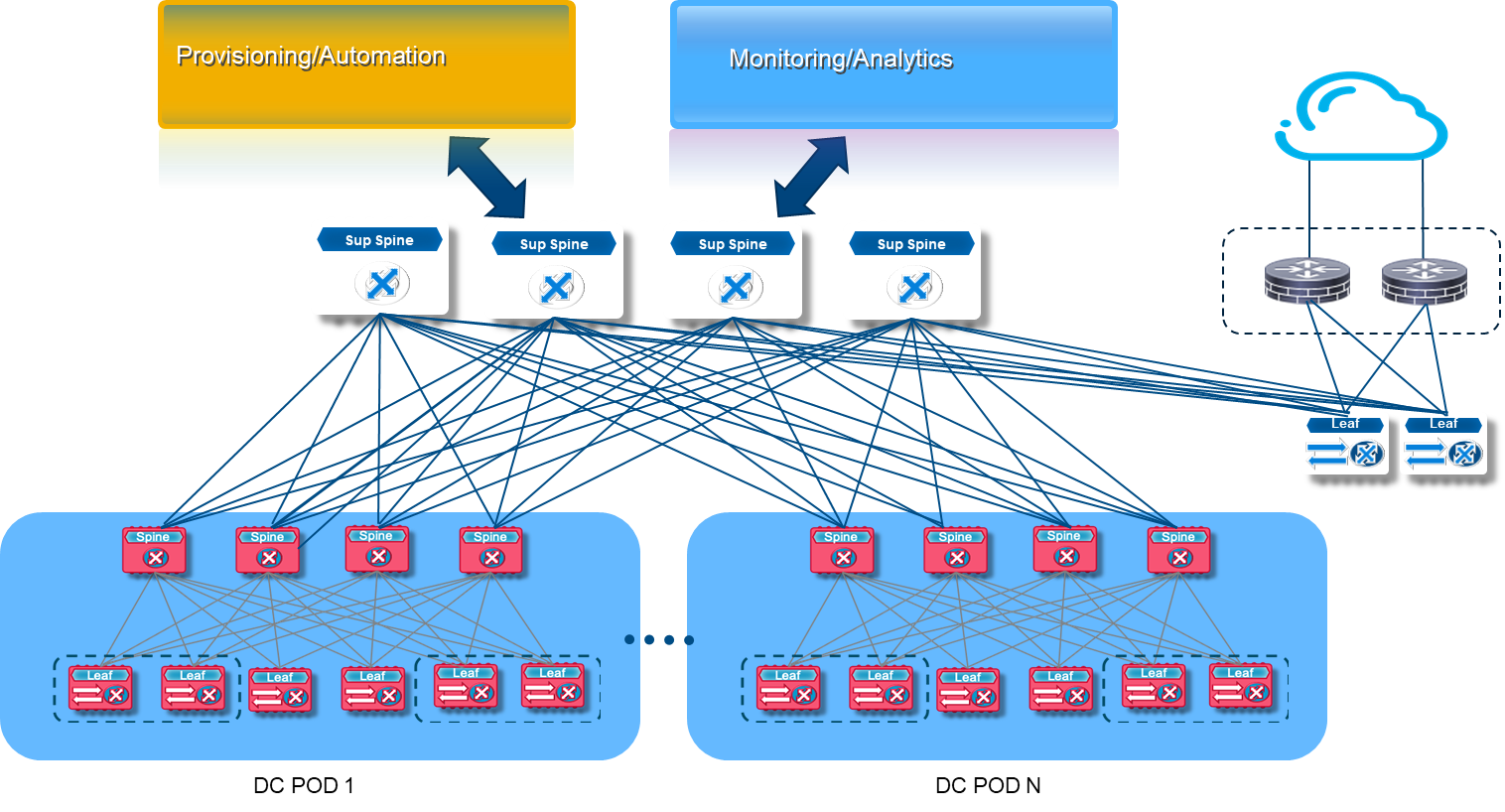 Figure 2—Scalable Layer 3 underlay in a data center
Figure 2—Scalable Layer 3 underlay in a data centerThe following benefits are worth noting:
- Simplicity—BGP-based configurations provide scale-out architecture and repeatable deployments with standards-based BGP, VLANs, unnumbered interfaces, ACLs, QoS, and VRRP implementations
- Cost Effective—The architecture is based on merchant silicon and Dell Technologies hardware with end-to-end support
Use case 2—Scalable multitenancy EVPN VXLAN
The second use case delivers fabric scalability by leveraging BGP EVPN VXLAN features. The following figure shows a fabric consisting of a spine layer and a leaf layer. Two tenants, A and B, are deployed and capable of communicating within and across each other while maintaining complete communications privacy between tenants.
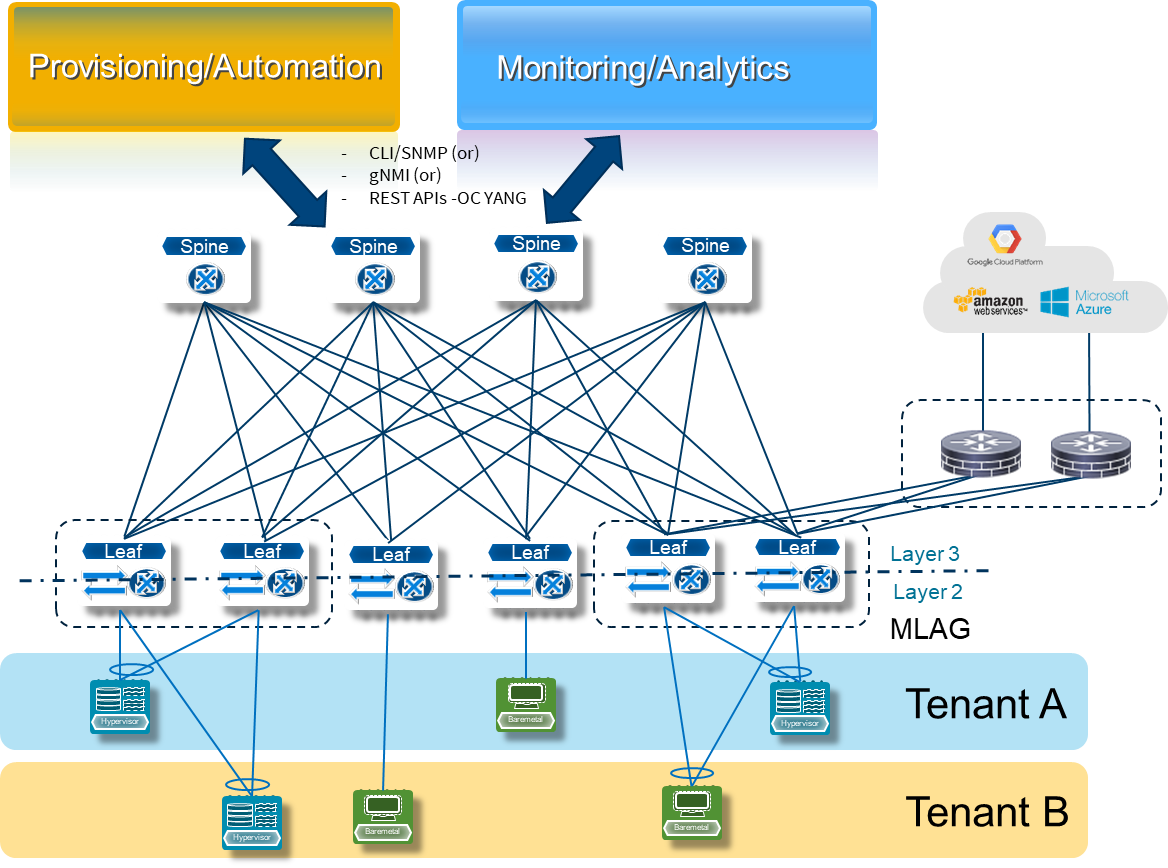 Figure 3—Multitenancy with VXLAN EVPN
Figure 3—Multitenancy with VXLAN EVPNA fabric that is based on EVPN VXLAN has two notable features:
- Scalability—VXLAN increases the number of VLANs from 4,000 (802.1q) to 16 million
- Efficiency—EVPN brings an efficient use in control plane across the network to establish full connectivity
Use case 3—Uniform routing to the host
The first use case provides a simple architecture that is based on open standards and builds the framework. The second use case expands the framework and makes it elastic. The third use case creates a uniform Layer 3 environment from the spine and leaf to the host, as shown in the following figure.
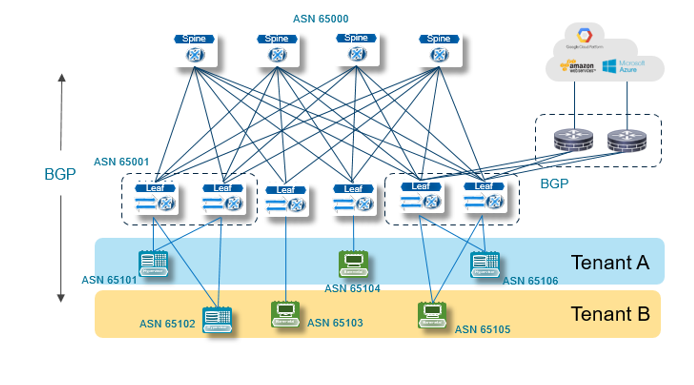 Figure 4—Routing to the host
Figure 4—Routing to the hostUniform routing to the host provides:
- Pure Layer 3 functionality—Basic Layer 2 features such as Spanning-Tree, VLANs, and MLAG are eliminated
- IP addressing efficiency—Efficient IP addressing that leverages BGP unnumbered configuration
- Host and VM agility—End-host physical rack decoupling and VM mobility
Additional information
For more about Enterprise SONiC Distribution by Dell Technologies, see the following:
